Table of Contents
- Introduction
- Editor’s Choice
- Global Farm Management Software Market Overview
- Adoption of Agtech Across Different Regions
- Precision Agriculture Hardware Adoption
- Farm Software Usage by Farmers
- Well-known Farm Management Software Providers Statistics
- Barriers to the Adoption of Farm Management Software Statistics
- Conclusion
- FAQs
Introduction
Farm Management Software Statistics: Farm management software streamlines farming tasks with features like crop monitoring, crop planning, inventory control, financial monitoring, equipment upkeep, labor organization, data assessment, and reporting.
It empowers farmers to oversee field operations, monitor resource usage, track costs, manage machinery, plan activities, analyze data patterns, and create summaries.
Through integration and mobile access, farmers can link with various farming tools and stay informed wherever they are.
Ultimately, farm management software boosts efficiency, eco-friendliness, and profitability in contemporary farming methods.
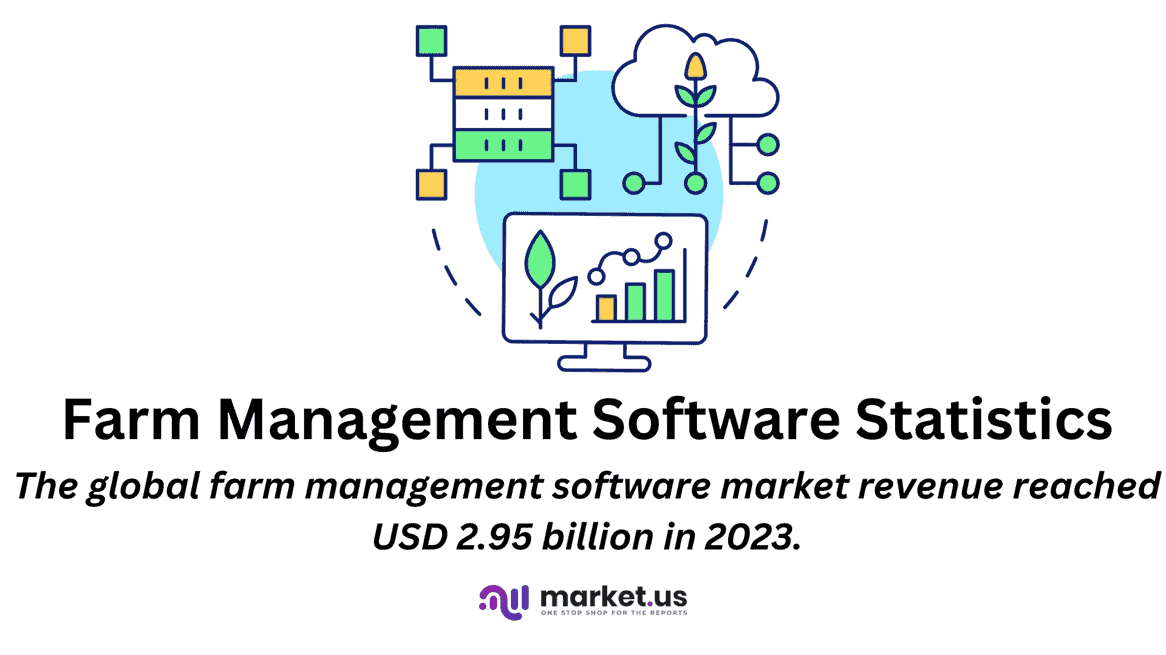
Editor’s Choice
- The global farm management software market revenue reached USD 2.95 billion in 2023.
- By 2032, the total market revenue surged to USD 8.94 billion, with precision farming dominating at USD 4.04 billion, followed by livestock monitoring at USD 2.54 billion, fish farming at USD 1.34 billion, and smart greenhouse farming at USD 1.02 billion.
- The delivery model market share analysis reveals that cloud-based solutions command a significant portion, holding 65% of the market, while local/web-based options comprise the remaining 35%.
- North America leads the farm management software and data analytics market with a revenue of $498.95 million, reflecting the region’s advanced agricultural practices and technological adoption.
- Farm management software is the top use case globally, with a 39% adoption rate.
- 63% of respondents reported using farm software in some capacity, indicating a significant adoption of technology within the agricultural sector.
- Farmers’ primary concern currently revolves around rising input prices, with 67% citing it among their top three profitability concerns for the next two years.
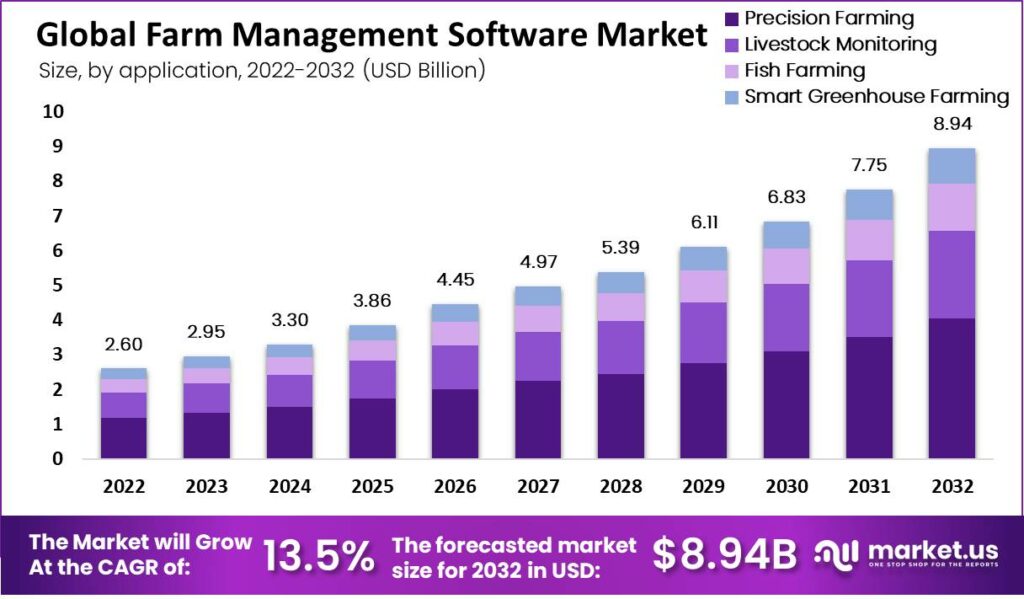
Global Farm Management Software Market Overview
Global Farm Management Software Market Size Statistics
- The global farm management software market has demonstrated steady growth in revenue over the past decade at a CAGR of 13.5%.
- Starting at USD 2.60 billion in 2022, the market saw incremental increases, reaching USD 2.95 billion in 2023 and further expanding to USD 3.30 billion in 2024.
- Projections indicate continued growth, with anticipated revenues of USD 3.86 billion in 2025 and USD 4.45 billion in 2026.
- By 2027, the market is forecasted to reach USD 4.97 billion, followed by USD 5.39 billion in 2028.
- As the adoption of farm management software continues to rise, revenue is expected to surge to USD 6.11 billion in 2029 and USD 6.83 billion in 2030.
- The market is poised for substantial growth, with revenues projected to exceed USD 7.75 billion in 2031 and USD 8.94 billion in 2032.
- This growth trajectory reflects the increasing importance of digital solutions in enhancing agricultural productivity and efficiency globally.
(Source: Market.us)
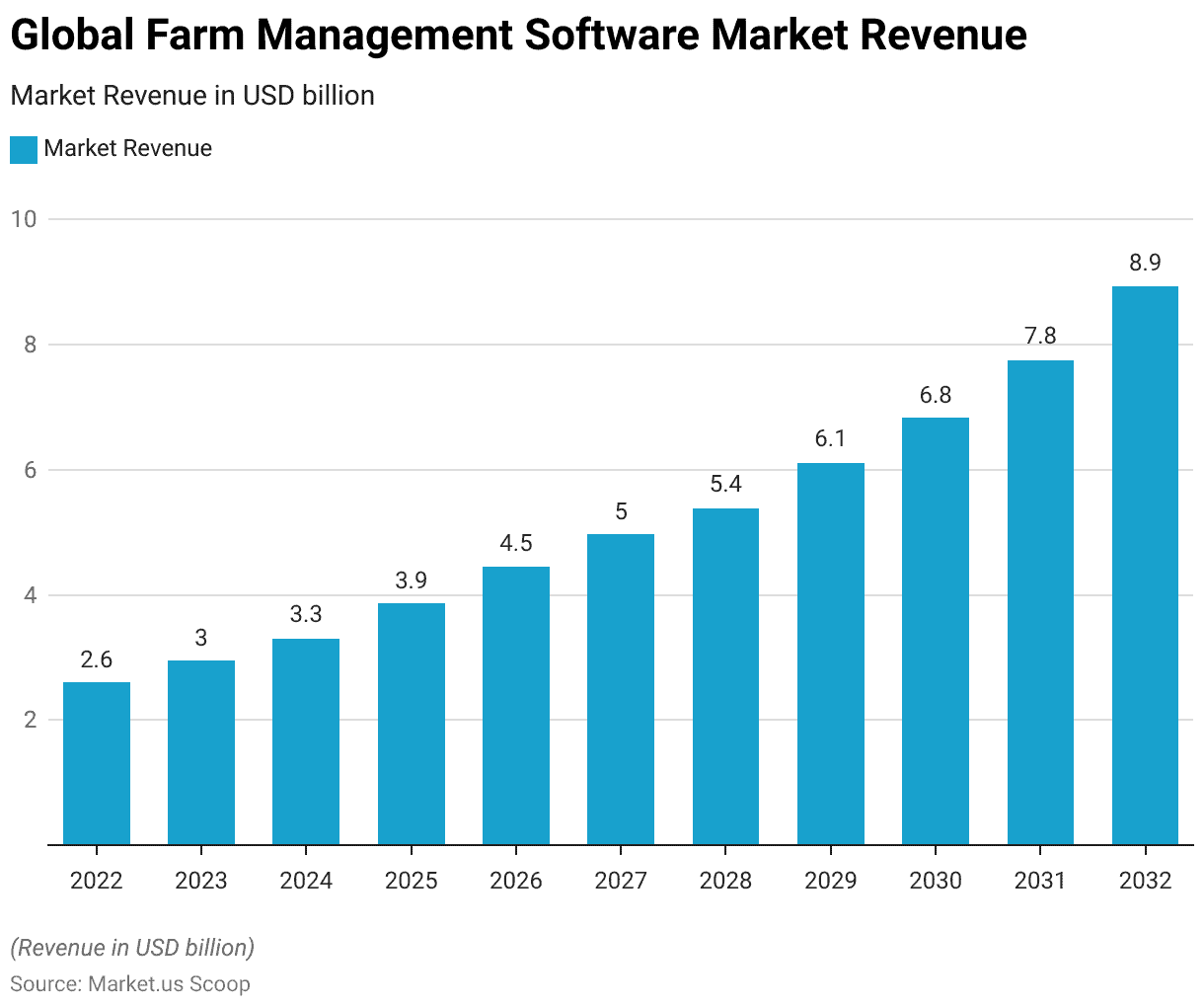
Global Farm Management Software Market Size – By Application Statistics
- The global farm management software market, segmented by application, showcases robust growth across various sectors.
- In 2022, the total market revenue stood at USD 2.60 billion, with precision farming contributing USD 1.18 billion, livestock monitoring at USD 0.74 billion, fish farming at USD 0.39 billion, and smart greenhouse farming at USD 0.30 billion.
- Over the subsequent years, each application segment experienced consistent expansion.
- By 2032, the total market revenue surged to USD 8.94 billion, with precision farming dominating at USD 4.04 billion, followed by livestock monitoring at USD 2.54 billion, fish farming at USD 1.34 billion, and smart greenhouse farming at USD 1.02 billion.
- This growth trend underscores the increasing adoption of farm management software across diverse agricultural practices, driving efficiency, productivity, and sustainability in the global farming industry.
(Source: Market.us)
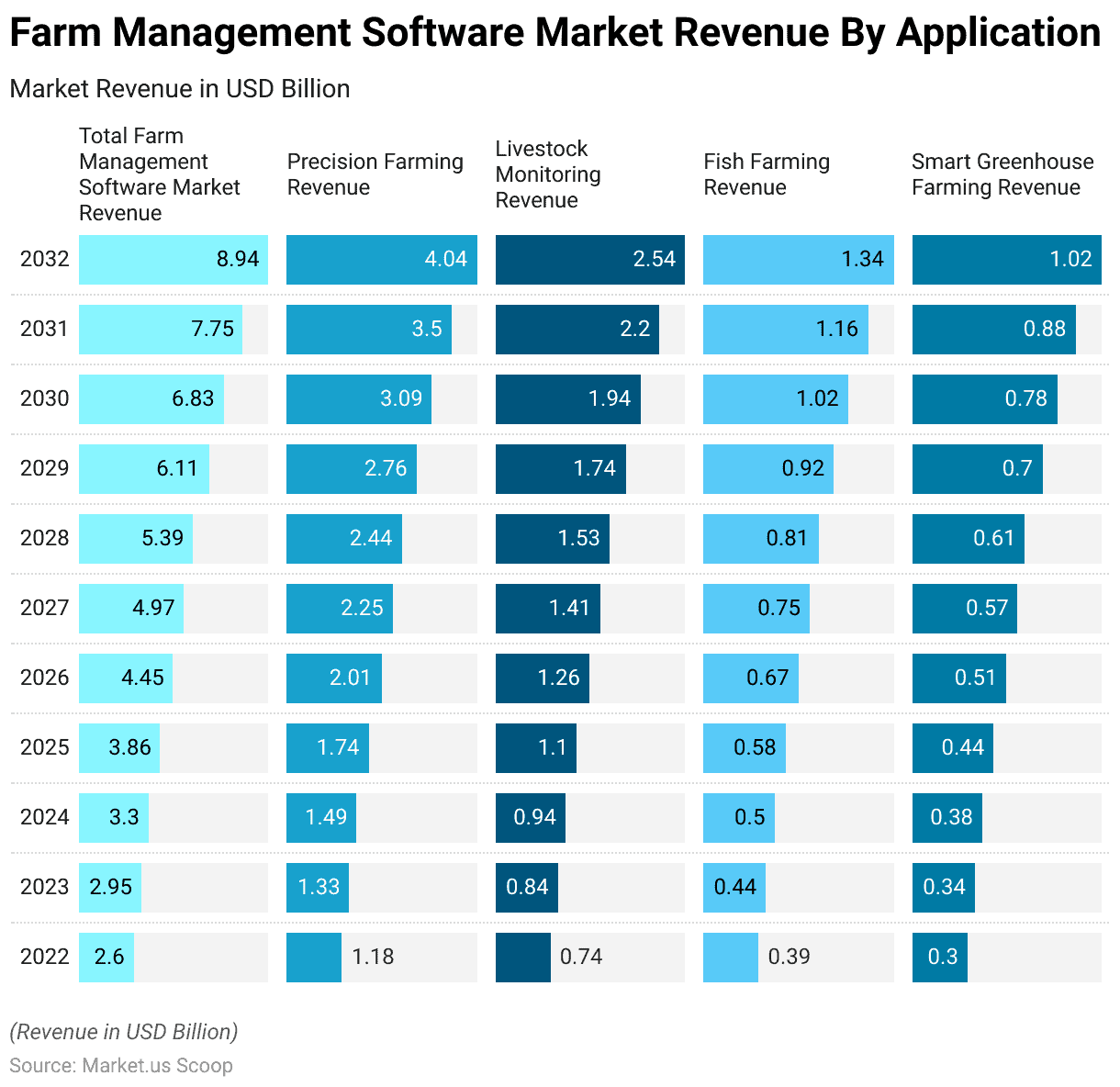
Global Farm Management Software Market Share – By Delivery Model Statistics
- The delivery model market share analysis reveals that cloud-based solutions command a significant portion, holding 65% of the market, while local/web-based options comprise the remaining 35%.
- This distribution indicates a clear preference for cloud-based delivery mechanisms, likely due to flexibility, scalability, and ease of access.
- Cloud-based platforms allow users to access farm management software from anywhere with an internet connection, facilitating real-time data management and decision-making.
- Conversely, although still relevant, local/web-based solutions may appeal to users who prioritize data control or operate in areas with limited internet access.
- However, the dominance of cloud-based delivery signifies the increasing trend towards digitalization and the adoption of Software-as-a-Service (SaaS) solutions within the agricultural sector.
(Source: Market.us)
Take advantage of our unbeatable offer - buy now!

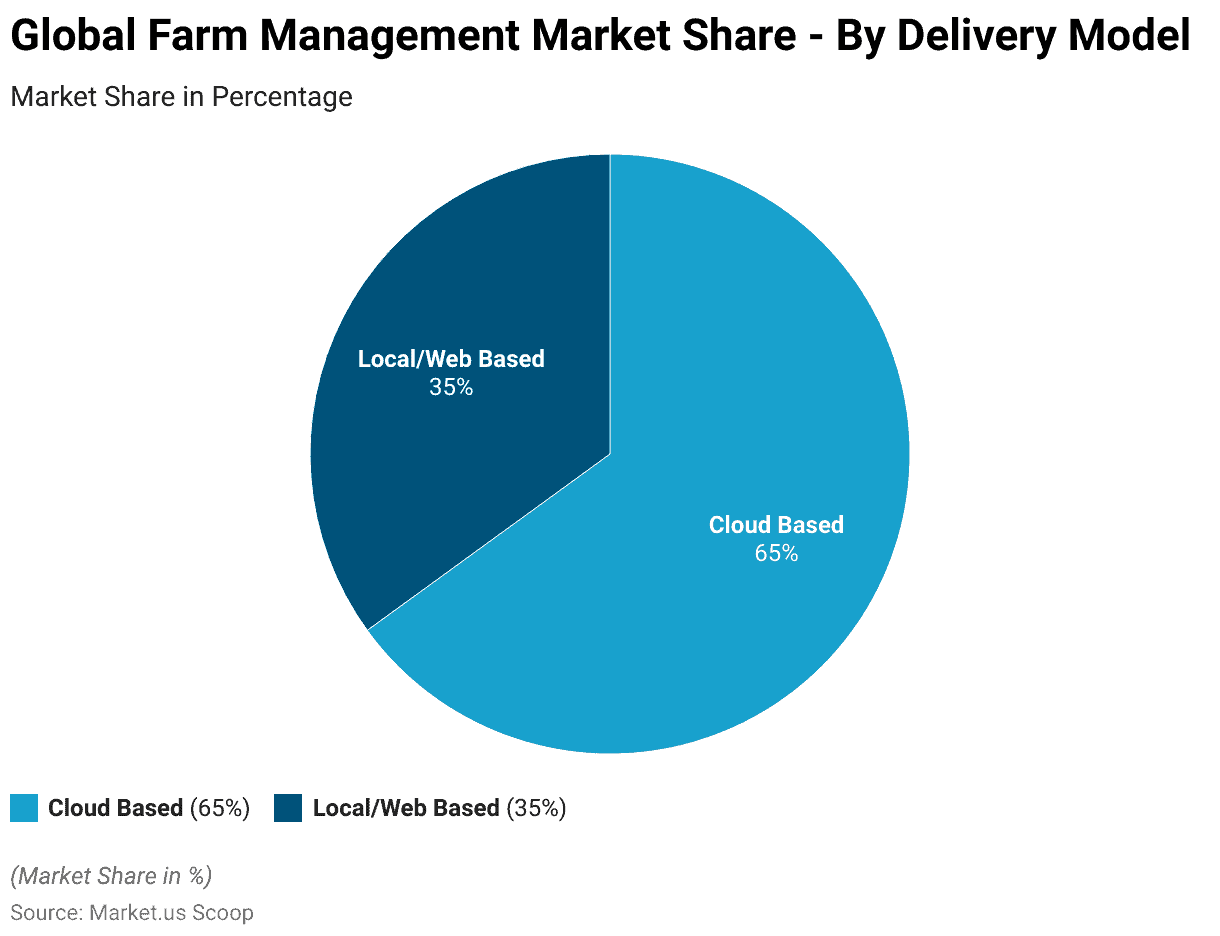
Farm Management Software and Data Analytics Market Revenue in Different Regions Statistics
- The global market revenue for farm management software and data analytics is projected to grow substantially from 2020 to 2026, as indicated by revenue figures in millions of U.S. dollars across various regions.
- North America leads the market with a revenue of $498.95 million, reflecting the region’s advanced agricultural practices and technological adoption.
- Europe follows with $193.49 million, while the Asia Pacific region demonstrates significant potential with a $179.2 million revenue driven by emerging economies and increasing agricultural digitalization.
- South America contributes $80.46 million to the market, indicating a growing interest in farm management software and data analytics within the region.
- China and the United Kingdom represent notable figures, with revenues of $40.55 million and $38.6 million, respectively, highlighting their contributions to the global market.
- The Middle East and Africa region show a revenue of $31.71 million, signaling a nascent but growing market for farm management software and data analytics.
- These figures underscore the global demand and investment in digital solutions to enhance agricultural productivity and efficiency.
(Source: Statista)
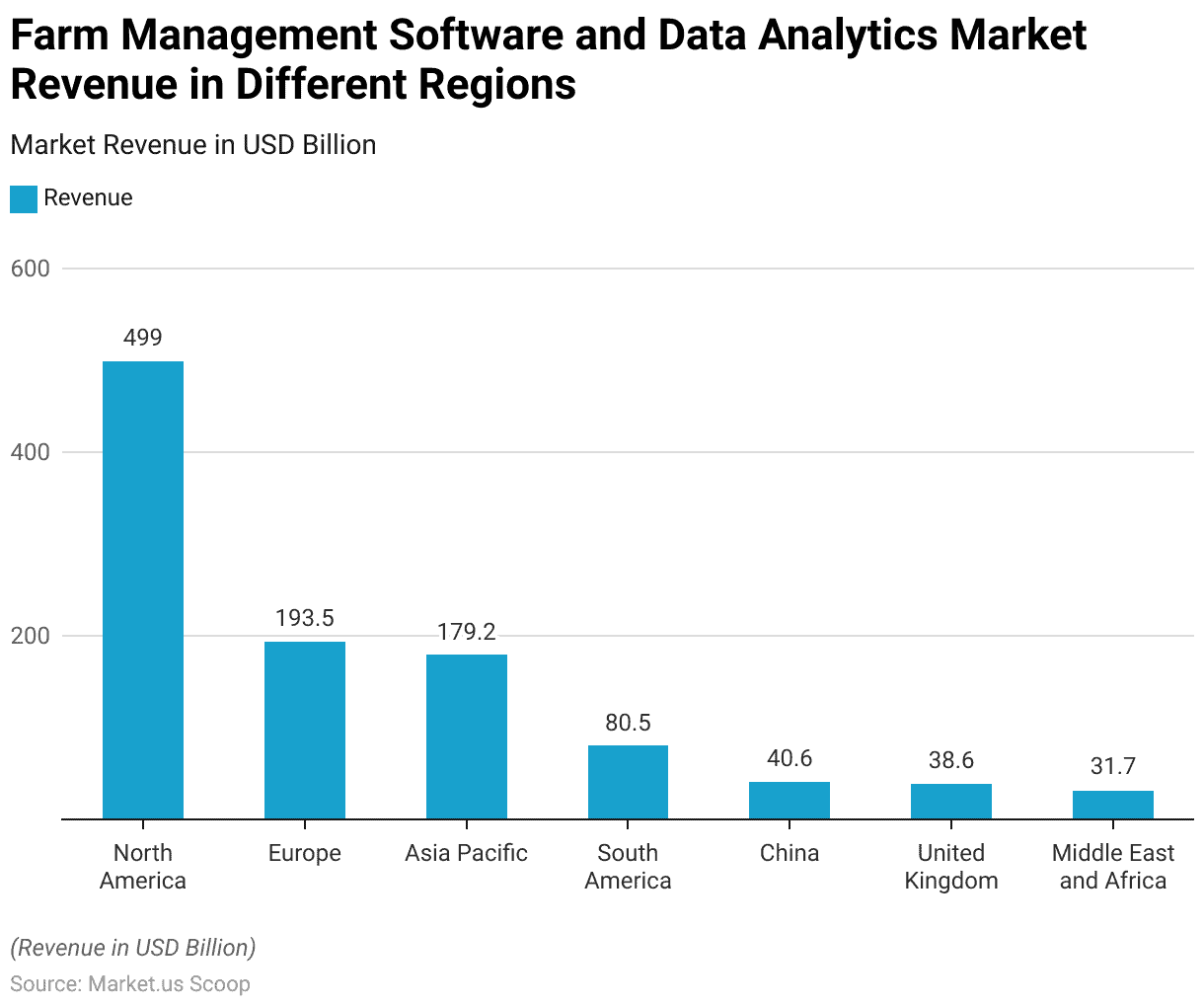
Adoption of Agtech Across Different Regions
- According to a recent survey on global agtech adoption, the utilization of various technologies varies across different regions.
- Farm management software is the top use case globally, with a 39% adoption rate.
- A combination of farm management software and remote sensing is prevalent in Europe, with a 62% adoption rate.
- Similarly, farm management software stands out as the most popular use case in North America, with a 61% adoption rate.
- South America demonstrates a preference for remote sensing technologies, with a 50% adoption rate.
- Conversely, farm automation and robotics emerge as the most favored use-case in Asia, albeit with a relatively lower adoption rate of 9%.
- These regional disparities in agtech adoption underscore the diverse agricultural landscapes and priorities worldwide, reflecting varying needs, challenges, and technological readiness levels among farming communities.
(Source: Mckinsey)
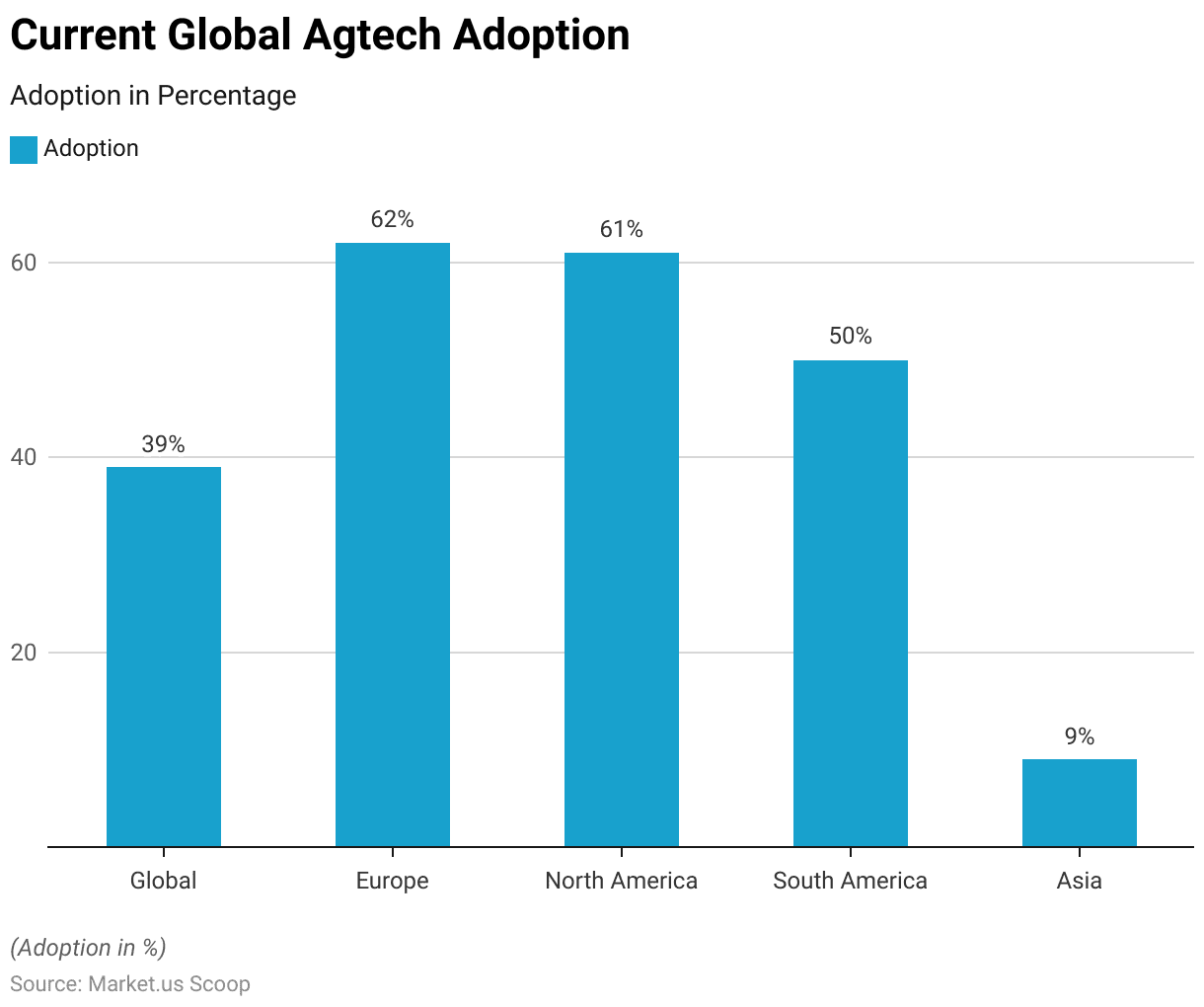
Precision Agriculture Hardware Adoption
- Precision agriculture hardware adoption rates vary across different regions globally.
- In North America and Europe, adoption stands at 18% and 21%, respectively, indicating a moderate level of uptake.
- South America shows a higher adoption rate at 27%, suggesting a greater acceptance and implementation of precision agriculture technologies in the region.
- Conversely, Asia lags with only 4% adoption, indicating a lower adoption level than other regions.
- These figures highlight the varying levels of technological integration and agricultural practices worldwide, influenced by economic conditions, infrastructure development, and government support for agricultural innovation.
(Source: Mckinsey)
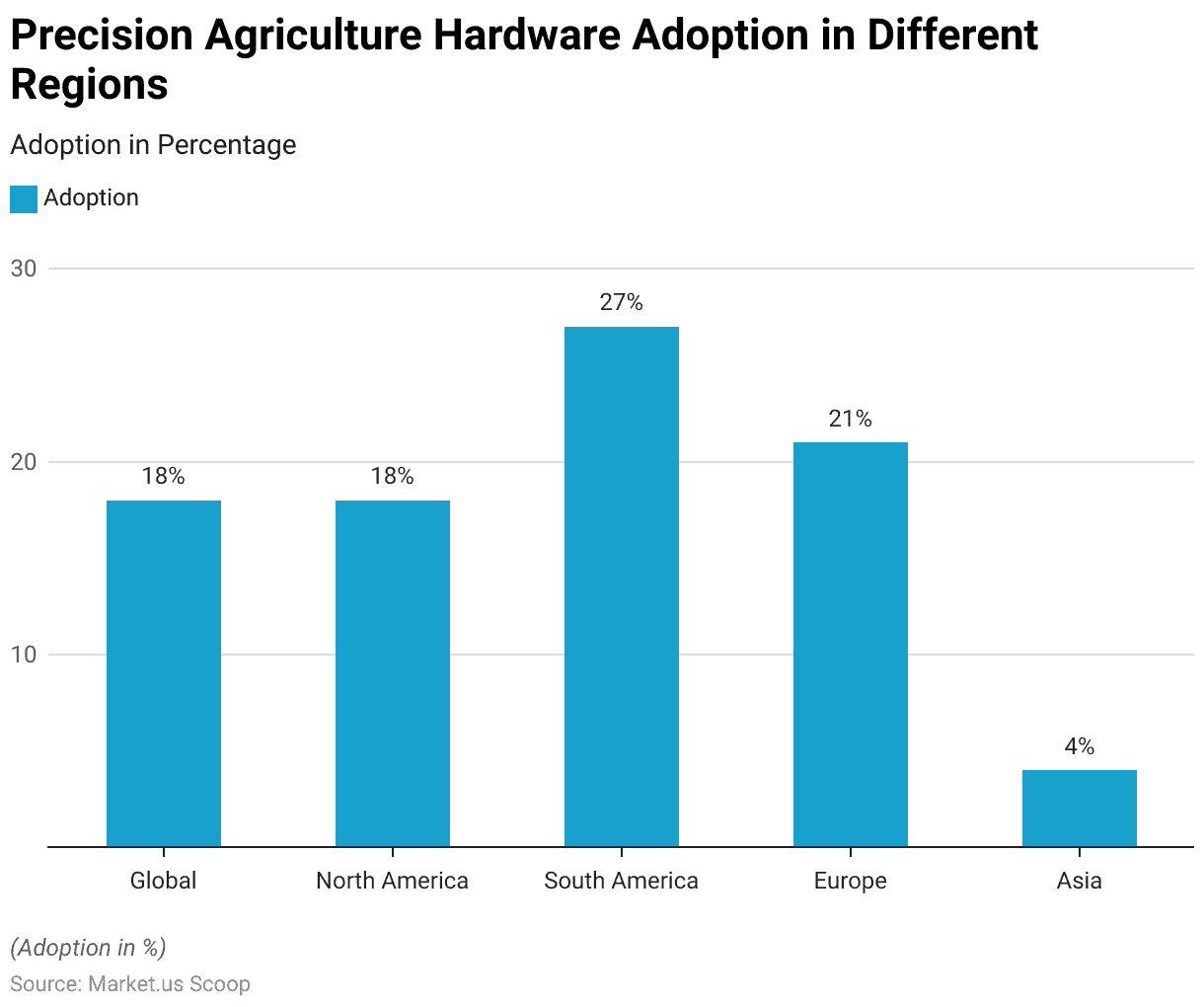
Current and Future Precision Agriculture Hardware Adoption
- According to the survey data, a significant percentage of respondents globally are adopting or planning to adopt precision agriculture hardware over the next two years.
- Yield monitoring and mapping have the highest adoption or planned adoption rate at 69%, followed closely by variable rate fertilizer application and sprayer section controllers, both at 67%.
- In-field soil sensors also show considerable interest, with a 75% adoption or planned adoption rate. Regionally,
- North America leads in adoption rates across all categories, with exceptionally high percentages for yield monitoring and mapping (76%) and variable rate fertilizer application (76%).
- South America follows closely with even higher adoption rates, notably for sprayer section controllers (77%) and yield monitoring and mapping (79%).
- In contrast, Europe exhibits lower adoption rates, with only 40% planning to adopt yield monitoring and mapping and variable rate fertilizer application and 53% for sprayer section controllers.
- Asia also shows moderate adoption intentions, with 42% planning to adopt yield monitoring, mapping, and variable rate fertilizer application and 44% for sprayer section controllers.
- These findings reflect varying levels of readiness and interest in precision agriculture technologies across different regions, influenced by factors such as agricultural practices, technological infrastructure, and economic conditions.
(Source: Mckinsey)
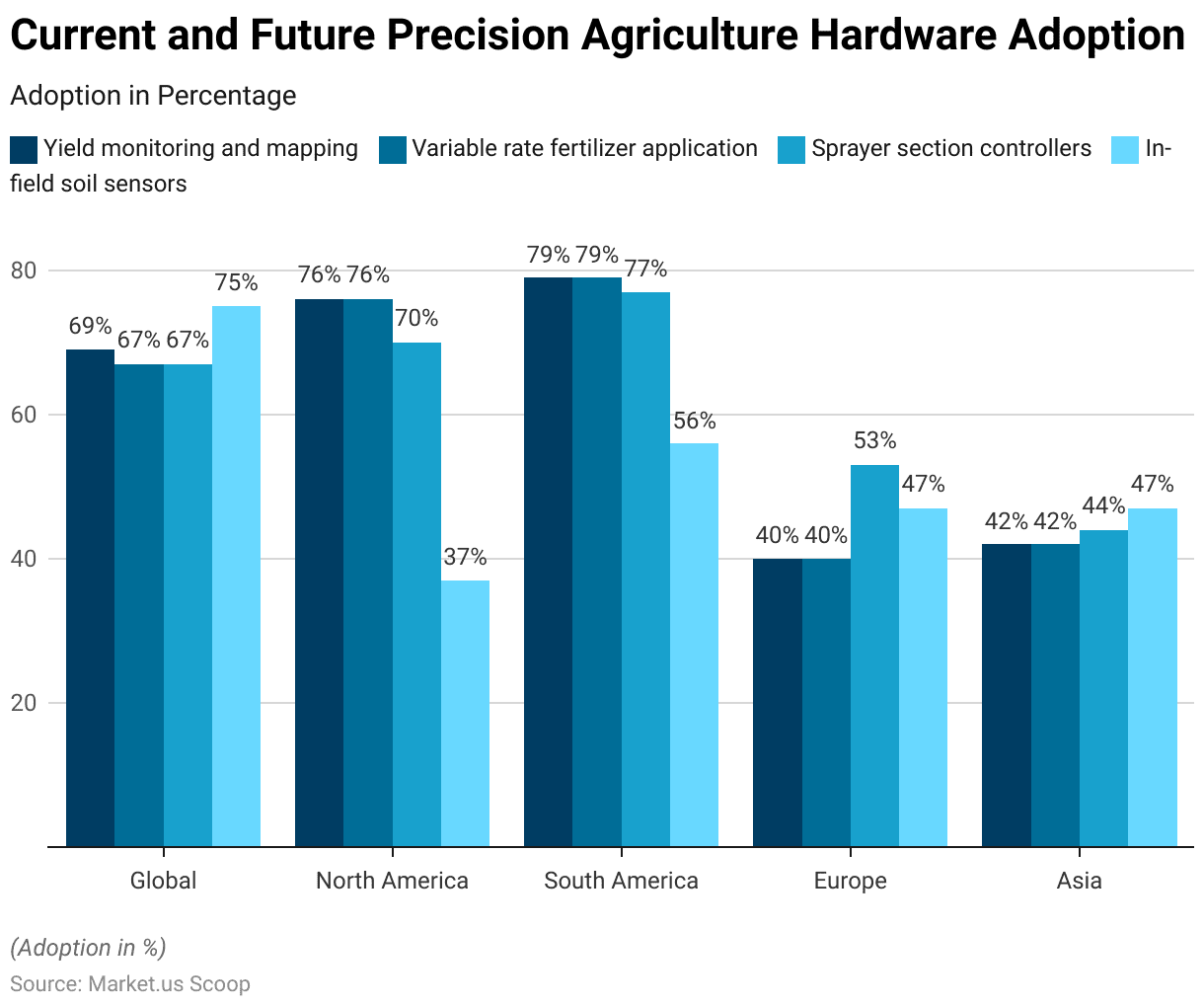
Farm Software Usage by Farmers
- According to the survey results, many farmers utilize various types of software to aid their operations.
- The data reveals that 63% of respondents reported using farm software in some capacity, indicating a significant adoption of technology within the agricultural sector.
- Furthermore, 42% of farmers indicated using industry-specific software tailored to their particular agricultural niche, suggesting a targeted approach to software adoption.
- Additionally, 37% reported using resource management software, emphasizing the importance placed on efficient utilization of resources within farming operations.
- Financial management software is particularly prevalent among farmers, with 84% utilizing such tools to manage their finances effectively.
- Interestingly, 18% of respondents reported using all three types of software, highlighting a subset of farmers who have embraced a comprehensive approach to digital tools in their farming practices.
- These findings underscore the increasing reliance on software solutions within the agricultural industry, reflecting a shift towards digitalization and efficiency optimization in modern farming practices.
(Source: Australian Government Rural Industries Research and Development Corporation)
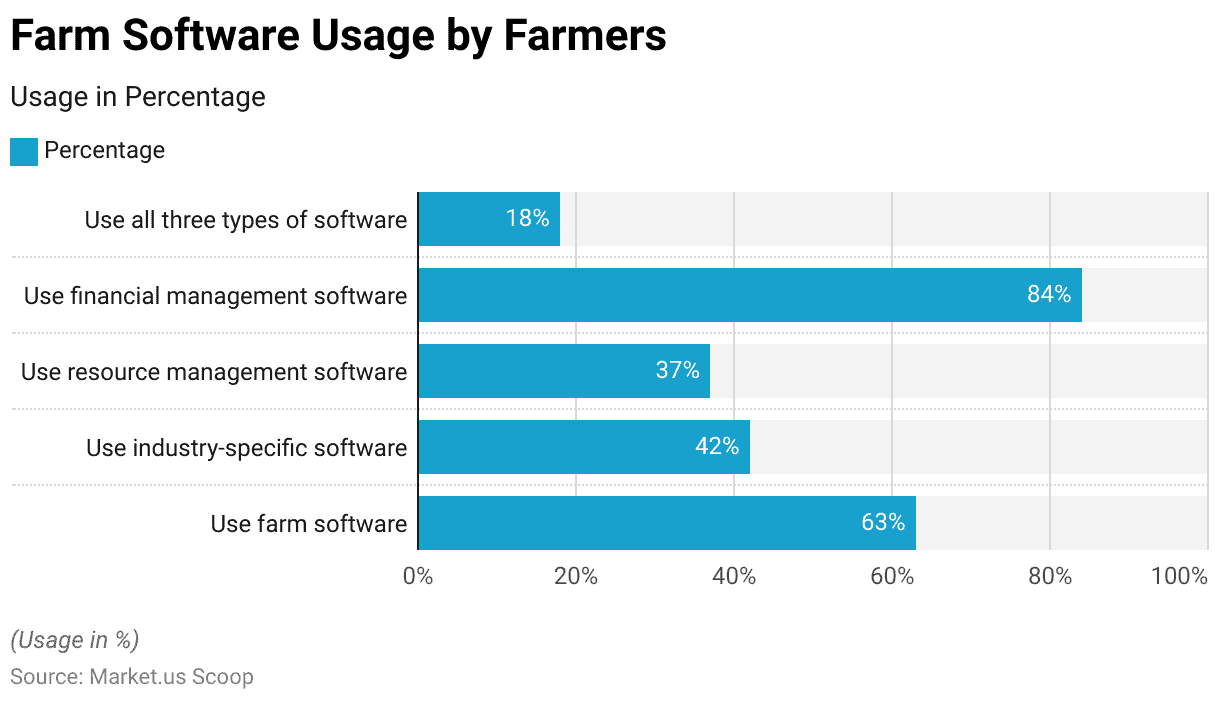
Well-known Farm Management Software Providers Statistics
eFishery
- eFishery provides shrimp and fish farmers with an Internet of Things (IoT) solution and data platform to enhance productivity and efficiency.
- Their intelligent feeder device enables farmers to monitor and automate feeding through a smartphone application.
- Additionally, the company gathers data on various parameters such as feeding, production, and water quality to offer predictive insights to farmers.
- Using eFishery’s feeders, aquaculture farmers have achieved notable results, including a reduction in cultivation cycle duration from 120 days to 90 days and a significant decrease in feed input by 21%.
- As of November 2019, approximately 3,000 eFishery feeders were in operation, serving 1,300 fish farmers.
AquaConnect
- AquaConnect offers shrimp farmers water quality monitoring, advisory assistance, and market access through its mobile application and on-the-ground agents.
- Their app, ‘FarmMojo,’ enables farmers to input data on water quality, feed usage, and shrimp health, which AquaConnect then analyzes to offer timely recommendations.
- As of November 2019, AquaConnect had automated 800 farm ponds, benefiting 3,000 farmers across three Indian states.
- The company is extending its services to Indonesia, aiming to broaden its operational reach.
(Source: Farmfit 2019)
CropIn
- Founded in 2010, CropIn offers Software-as-a-Service agricultural solutions to optimize per-acre productivity and guarantee farm traceability.
- Employing a business-to-business approach, the company collects farm-specific data and provides data-led advisory assistance through its mobile application, SmartFarm.
- CropIn leverages sophisticated technologies such as big data analytics, artificial intelligence, remote sensing, and machine learning to deliver its advisory services.
- By November 2019, CropIn had positively influenced over 2.1 million farmers and digitized 5.6 million acres of agricultural land spanning 47 countries worldwide.
(Source: Farmfit 2019)
Koltiva
- Koltiva is a technology and service provider offering tailored sustainability management and product traceability software solutions to agribusinesses.
- With a suite of 8 applications and four associated solutions, including FarmXtension and FarmCloud, the company gathers real-time farm-level data to assist farmers in enhancing productivity and minimizing crop losses.
- These applications also facilitate post-production connections with buyers while ensuring traceability. Koltiva’s solutions have benefited more than 237,000 farmers and digitized approximately 650,000 acres of farmland.
(Source: Farmfit 2019)
SourceTrace
- Founded in 2007, SourceTrace Systems is a Software-as-a-Service (SaaS) company offering farmer-focused mobile applications to streamline agriculture value chains and empower smallholder farmers to access global markets.
- Their “DataGreen” app aids farm management through advisory services, certification, traceability mapping, supply chain management, and market connections.
- SourceTrace has positively impacted the lives of more than 1 million farmers and digitized over 2.4 million acres of farmland.
(Source: Farmfit 2019)
Barriers to the Adoption of Farm Management Software Statistics
- A more precise focus on return on investment (ROI) is essential to encourage greater adoption. According to 30% of farmers surveyed, an unclear ROI is a significant barrier to adoption. Based on their feedback, the minimum expected ROI for adoption is 3:1.
- Usage-based pricing models, such as cost per acre or module per acre, are widely prevalent, ranging from as low as $1 to as high as $60 per acre. Although these models appeal to agtech companies, even products with lower pricing per acre have faced challenges in scaling up.
- Leasing or renting models with minimal upfront hardware costs and scalable pricing structures like per-acre, module, or sensor-based pricing are anticipated to facilitate greater adoption. This is especially significant as 31% of farmers foresee lower profits in the coming years.
- Apart from cost and ROI, farmers are apprehensive about data access, with 20% globally citing it as a top barrier to adopting farm-management software.
- North American farmers exhibit the highest concerns about data sharing (25%), while Asian farmers are the least concerned (18%).
- Digital channels for farmers to learn about and purchase products need more focus. Despite interest from start-ups and established companies in online platforms, less than 12% of farmers worldwide strongly prefer buying products online.
- Farmers’ primary concern currently revolves around rising input prices, with 67% citing it among their top three profitability concerns for the next two years.
- Global farmers have experienced input price increases ranging from approximately 80% to 250% in recent years.
- South American farmers have been particularly affected, experiencing a rise of about 247%, while Asian farmers have faced comparatively lower increases of around 82%.
- Despite producing food under heightened sales prices, the unpredictability of commodity markets and rising input costs add significant uncertainty to future profitability.
(Source: McKinsey)
Conclusion
Farm Management Software Statistics – Farm management software is becoming more crucial in contemporary agriculture, offering farmers tools to boost effectiveness and output. Utilizing Software-as-a-Service platforms, farmers can obtain customized solutions for planning crops, managing inventory, and tracking finances.
While its significance grows, challenges like data privacy worries and accessibility in developing areas endure. Yet, the future of farm management software looks promising, propelled by advancements in technology.
As the sector progresses, farm management software will remain pivotal in aiding farmers in overcoming obstacles, enhancing sustainability, and thriving in today’s agricultural realm.
FAQs
Farm management software is a technology solution designed to assist farmers in managing various operations, including crop planning, inventory management, financial tracking, and data analysis. It helps streamline processes and improve efficiency on the farm.
Critical features of farm management software typically include crop planning tools, inventory tracking, financial management modules, labor management, data analytics, and reporting capabilities. Some advanced systems may also incorporate weather forecasting and integration with IoT devices.
Farm management software helps farmers increase productivity, optimize resource allocation, improve decision-making through data insights, reduce operational costs, streamline workflows, and enhance farm profitability. It also enables better compliance with regulations and certifications.
Farm management software can be adapted to various types of farms, including crop farms, livestock operations, orchards, vineyards, and mixed-use farms. The software can be customized to meet different agricultural enterprises’ needs and requirements.
Farm management software is typically available as a cloud-based solution or can be installed on-premises. Cloud-based software offers the advantage of accessibility from anywhere with an internet connection and often includes automatic updates and data backups.
Discuss your needs with our analyst
Please share your requirements with more details so our analyst can check if they can solve your problem(s)



